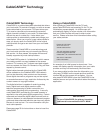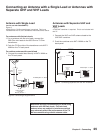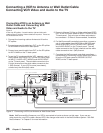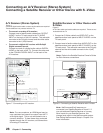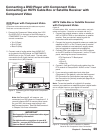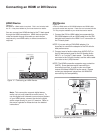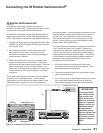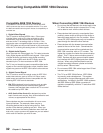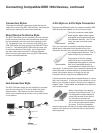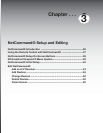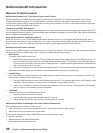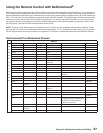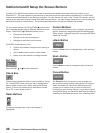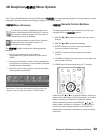32
Chapter 2. Connecting
When Connecting IEEE 1394 Devices
• Do not loop the last device in the chain back to the
TV. When the device chain is looped, the TV may
not be able to work with the other devices.
• Place devices that have only a mechanical (two-
position) power switch at the end of the chain or
leave the power switch in the On position. When
turned Off, IEEE 1394 signals may not be able to
pass through the device to other devices.
• Place devices with the slowest communication
speed at the end of the chain. Sometimes the
communication speed will be marked near the
IEEE 1394 connector with an “S” number. The
higher the number, the faster the communication
speed. This TV has a communication speed of
S400. Devices with slow communication speed
can interfere with IEEE 1394 signals from faster
devices. When using NetCommand to set up
a digital recording between a faster and slower
device, select “Record Later.”
• Do not use an IEEE 1394 cable longer than 15 feet
between each device.
• This TV is an IEEE 1394a Device. IEEE 1394b
is currently under development. This system
will provide for longer distances and multi-room
applications. Included in the IEEE 1394b systems
are IEEE 1394a to IEEE 1394b converters to
maintain compatibility with this TV and other IEEE
1394a devices.
Connecting Compatible IEEE 1394 Devices
Compatible IEEE 1394 Devices
It is possible to connect devices to the TV that have IEEE
1394 connectors but are not compatible with the TV or with
the NetCommand
®
control system. Areas of compatibility to
consider are:
1. Digital Video Signals
The TV is able to decode MPEG2 video. Other types
of digital video, such as DV video provided by some
camcorders, must be decoded by the source device
and sent to the TV as analog video or S-Video. If the
camcorder uses a compatible digital control system, the
IEEE 1394 cable can still provide control for the camcorder
while the TV is viewing the analog video or S-Video signals.
2. Digital Audio Signals
When received with video signals, the TV is able to decode
Dolby Digital signals and MPEG audio signals. Other types
of digital audio as provided by some digital recording
devices, such as MP3 audio and DTS audio, cannot be
decoded by the TV when received over IEEE 1394.
The TV may not be able to pass incompatible digital audio
signals on the coaxial digital audio output, however these
signals may pass on the IEEE 1394 cable to other devices.
3. Digital Control Signal
The TV is able to act as the control center for IEEE 1394
audio/video devices, such as VCRs, A/V Discs, tuners,
cable boxes and amplifiers that are compatible with the
following IEEE 1394 control standards.
• EIA-775 is designed for tuning devices such as cable
boxes allowing the device to send simple graphics.
However, this standard does not allow the TV to control
the cable box by IEEE 1394.
• AV/C (Audio Video Control) is designed to provide
basic controls such as play, stop, channel selection and
volume, as appropriate for the device.
Some devices may be a combination of two or more
types of devices. For example, there may be a
recording device that is also a tuning device. Each
portion of the device is called a sub-unit. When you
select a device on the Device Selection menu that has
sub-units, a pop-up menu will appear so you can select
which sub-unit section you wish to use.



